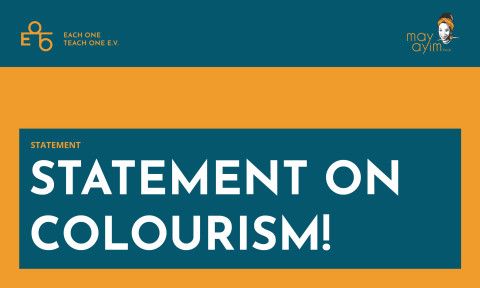Liebe Schwarzen Communities,
aufgrund eines Vorfalls, der sich vor Kurzem auf einer von EOTO organisierten Veranstaltung ereignet hat, wollen wir mit euch zu Colourism sprechen.

Die Community Veranstaltung stellte keinen safer space mehr für alle Beteiligten, insbesondere die dark-skinned Teilnehmenden dar. Wir sehen uns als Schwarzer Bildungs- und Empowerment Verein in der Verantwortung, den Diskurs zu Colourism mitzutragen.
Dear Black Communities,
Due to an incident that happened recently at an event organised by EOTO, we want to talk to you about colourism. The community event was no longer a safe space for all participants, especially the dark-skinned participants. As a black education and empowerment association, we see it as our responsibility to contribute to the discourse on colourism.
What is Colourism?
Colourism has a classist, colonial-historical and anti-Black background. It describes the social marginalisation and systematic oppression of people based on their skin shades and features such as hair, eyes, nose, lips and other phenotypical characteristics (featurism / texturism) - favouring proximity to whiteness.
The distinction between traditional understandings of racism (tR) and colourism is made clear by the different points of reference. In tR, people are assigned to discrete racist categories and value is placed on ancestry. Colourism, on the other hand, allows for a deeper understanding of discrimination along the black-white colour line and more complex racist relations, such as making visible in the workplace how light-skinned workers are usually favoured over their dark-skinned colleagues in management positions.
Framing the debate on colourism
Leading the debate on colourism
Discussions on colourism are about making visible the complexity of structural racist relations and not about dismissing individual experiences of violence and discrimination.
The denial of one's own privileges, despite individual experiences of discrimination, leads to aggression within our communities, or represents a form of colourist violence against dark-skinned people. In our specific case, the activist and educational work of our speaker Mami Wata Mayowa was also discredited.
The centring of dark-skinned experiences
However, the centring of dark-skinned experiences in the discourse on colourism recognises the group most structurally affected by colourist and anti-Black violence, which at the same time brings with it a deeper understanding of it.
For these reasons, we not only want to clearly position ourselves in support of dark-skinned people, but also to commit to long-term action on colourism as an organisation.
The next steps and sustainable commitment
1. EOTO e.V. undertakes awareness training on colourism and addresses its own internal structures.
2. the affected dark-skinned people of the last event will be offered to heal from the colourist aggressions in a healing space.
3. in the coming weeks, in collaboration with @mayowasworld, we will share posts and videos that contribute to the clarification of colourist violence and the general discourse on colourism.
4. with these steps, we hope to inspire more organisations and individuals to engage with the issue in more depth and make community events safer spaces again.
–
Liebe Schwarzen Communities,
aufgrund eines Vorfalls, der sich vor Kurzem auf einer von EOTO organisierten Veranstaltung ereignet hat, wollen wir mit euch zu Colourism sprechen. Die Community Veranstaltung stellte keinen safer space mehr für alle Beteiligten, insbesondere die dark-skinned Teilnehmenden dar. Wir sehen uns als Schwarzer Bildungs- und Empowerment Verein in der Verantwortung, den Diskurs zu Colourism mitzutragen.
Was ist Colourism?
Colourism hat einen klassistischen, kolonialgeschichtlichen und anti-Schwarzen Hintergrund. Es beschreibt die soziale Marginalisierung und systematische Unterdrückung von Menschen aufgrund ihrer Hautschattierungen und Merkmale wie Haare, Augen, Nase, Lippen und anderen phänotypischen Eigenschaften (Featurism / Texturism) – wobei Nähe zu Weißsein favorisiert wird.
Die Unterscheidung von traditionellen Rassismusverständnissen (tR) und Colourism wird durch die unterschiedlichen Bezugspunkte deutlich. Im tR werden Menschen diskreten rassistischen Kategorien zugeordnet und Wert auf die Abstammung gelegt. Colourism ermöglicht abgegrenzt dazu ein tieferes Versändnis der Diskriminierung entlang der schwarz-weißen Farblinie und komplexeren rassistischen Verhältnissen, wie z. B. am Arbeitsplatz die Sichtbarmachung davon, wie light-skinned Arbeitnehmende bei der Besetzung von Führungspositionen in der Regel gegenüber ihren dark-skinned Kolleg*innen bevorzugt werden.
Debattenführung zu Colourism
In Diskussionen um Colourism geht es darum, die Komplexität von strukturellen rassistischen Verhältnissen sichtbar zu machen und nicht individuelle Gewalt- und Diskriminierungserfahrungen abzuerkennen.
Die Verweigerung eigener Privilegien, trotz der individuellen Diskriminierungserfahrungen, führt zu Aggressionen innerhalb unserer Communities, bzw. stellt eine Form von koloristische Gewalt gegenüber dark-skinned Personen dar. In unserem konkreten Fall wurde auch die aktivistische und aufklärerische Arbeit von unserer Speaker*in @mayowasworld diskreditiert.
Die Zentrierung von dark-skinned Erfahrungen
Die Zentrierung von dark-skinned Erfahrungen im Diskurs zu Colourism anerkennt jedoch die strukturell am stärksten betroffene Gruppe durch koloristische und anti-Schwarze Gewalt, wodurch zugleich ein vertieftes Verständnis dessen damit einhergeht.
Aus diesen Gründen möchten wir uns nicht nur klar in Unterstützung zu dark-skinned Personen positionieren, sondern uns langfristig als Organisation mit geeigneten Maßnahmen zum Thema Colourism engagieren.
Die nächsten Schritte und nachhaltiges Commitment
1. EOTO e.V. unternimmt ein Sensibilisierungstraining zu Colourism und setzt sich mit eigenen internen Strukturen auseinander.
2. Den betroffenen dark-skinned Personen der letzten Veranstaltung wird angeboten, in einem Healing Space von den koloristischen Aggressionen zu heilen.
3. In den nächsten Wochen werden wir in Zusammenarbeit mit @mayowasworld Postbeiträge und Videos teilen, die zur Aufklärung von koloristischer Gewalt und dem allgemeinen geführten Diskurs zu Colourism beitragen.
4. Wir hoffen, mit diesen Schritten auch weitere Organisationen und Einzelpersonen zu inspirieren, sich mit der Thematik vertiefter zu befassen und Community-Veranstaltungen so auch wieder zu Safer Spaces zu machen.


 Play
Play